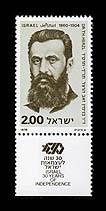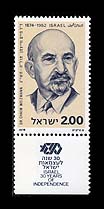|
The Jews have few heroes but they immortalise them. Herzl stands clearly among the chosen few in four thousand years of history" - says Jacob de Haas in his biography of the founder of the Zionist movement; the man who in nine short years of ceaseless toil created the political instrument which fifty years later, in full accordance with his prophetic vision, brought about the establishment of the State of Israel.
Herzl was born in 1860 in Budapest, Hungary; he studied Law, practised briefly and then established himself in Vienna as a journalist. An early believer in assimilation, he became disillusioned with it as a solution to the Jewish problem while covering the Dreyfus affair in Paris and watching the resurgence of anti-Semitism. In 1896 he published his pamphlet "Der Judenstaat, in which he expressed his conviction that the Jews were a people, one people and as such they must and should have a state of their own. He convened the first Zionist Congress in Basle in 1897, which drafted a constitution for the World Zionist Organisation and proclaimed the aims of the movement. Despite opposition from most of the recognised Jewish 'authorities, he won the enthusiastic support of the Jewish masses. He became Zionism's indefatigable diplomat, organiser and propagandist. He presided over the first six congresses, was President of the WZO, launched the "Jewish Colonial Trust", founded "Die Welt" and with a small group of ardent assistants put the Jewish people on the international diplomatic and political map.
In the cause of Zionism he met dozens of the world's leaders including the Turkish Sultan, the German Emperor (in Jerusalem), the Pope, the King of Italy, and British, Russian and Austrian cabinet ministers. He died on July 3, 1904 in Edlach, Austria, overworked, frustrated and embittered by the storm which the Uganda affair had aroused within the Zionist camp. He was buried in Vienna, and in 1949 his body was brought to Israel and reinterred on a hilltop in Jerusalem, known there-after as Mount Herzl.
Chaim Weizmann
The first President of the State of Israel was born in 1874 in Motol near Pinsk, Russia. He studied chemistry in Germany and Switzerland and in 1904 was appointed lecturer in Biological Chemistry at Manchester University. In 1915 he made an important contribution to the British war effort by developing a process for manufacturing synthetic acetone for explosives. His discovery made the British government sympathetic to proposals for a Jewish homeland in Palestine.
Having been instrumental in obtaining the Balfour Declaration, Weizmann (a Zionist leader since 1901) headed the Zionist Commission which went to Eretz Israel in 1918. In the same year he signed an agreement with the Emir Feisal on Jewish-Arab cooperation, and in 1919 he headed the Zionist delegation to the Peace Conference. In 1920 he was elected President of th World Zionist Organisation. His efforts led to the extension of the Jewish Agency of which he became chairman in 1929. Between 1931 and 1935 he was out of office, though still very active in Zionist affairs. He was President of the Hebrew University in Jerusalem which owes its existence to his vision, and in 1934 established the Daniel Sieff Research Institute in Rehovot, the nucleus of what is now the world-famous Weizmann Institute of Science. During World War II he again made important scientific contributions to the war effort, including the production of synthetic rubber. Having been re-elected President of the Zionist movement in 1935, he appeared as its proud and impressive spokesman before the various British and international commissions of inquiry for Palestine in the thirties and forties. When Israel declared its independence, he became chairman of the Provisional State Council. After the first Knesset elections, he was the natural choice for Israel's first President and was chosen for a second term in 1951. He passed away in 1952.


